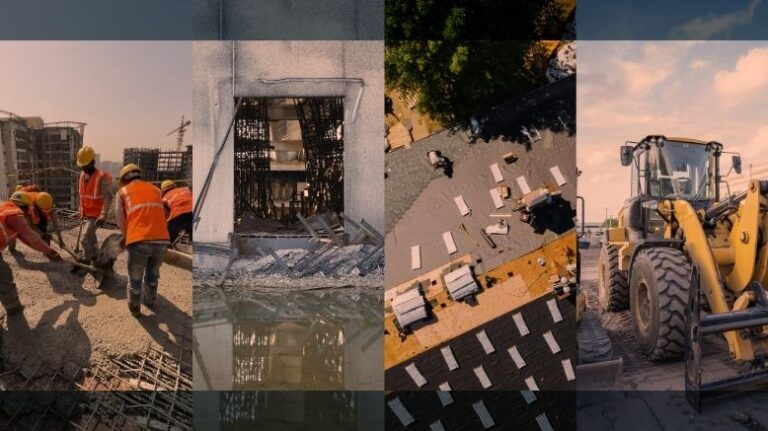Related Articles
— 7 min read
Construction Defects: What Contractors Need to Know

Last Updated Sep 22, 2025

Julia Tell
Contributing Writer
64 articles
Julia Tell is a freelance writer covering education, construction, healthcare, and digital transformation. She holds a Ph.D. in Media & Communications and has written for publications including Business Insider, GoodRx, and EdSurge, as well as nonprofits, international businesses, and educational institutions.
Last Updated Sep 22, 2025

Every builder aims to deliver high-quality projects that delight clients and enhance their reputation. However, construction defects—flaws in design, materials or workmanship—can emerge during or after construction, necessitating collaboration with owners for remediation. Understanding construction defects can help companies reduce the risk of delays and financial losses associated with defect claims.
While many defects can be resolved amicably, they can sometimes lead to significant failures, threatening health and property, or result in complex legal disputes over liability. It is the general contractor’s responsibility to meet contractual obligations and address any defects to ensure project integrity and client satisfaction.
This article explores construction defects, examining their types, causes and the impact on building projects. It provides insights into best practices for contractors to mitigate risks, outlines potential legal ramifications and offers strategies for effectively managing claims to maintain quality and minimize disputes.
Table of contents
What are construction defects?
Construction defects are flaws or deficiencies in the design, materials or workmanship that result in a building or structure failing to perform as intended or expected. They are defined within the framework of regulatory and contractual issues as any deviations from the agreed-upon construction specifications, standards or codes. Defects can manifest in various forms, affecting the structural integrity, safety and functionality of a construction project.
There are two main categories of construction defects: patent and latent. Patent defects are those that are readily observable and identifiable during the construction process or upon inspection after completion. These include visible issues like cracks in walls or improperly installed fixtures.
In contrast, latent defects are hidden problems that are not immediately apparent and may surface long after the project is completed, such as foundational issues due to poor soil compaction or defects in the internal structure of materials used.
Types of Construction Defects
Building defects can significantly impact a project's success and longevity. These defects are typically categorized into three main types:
Design Errors
Design errors occur when architectural or engineering plans contain inaccuracies or omissions, leading to unforeseen complications. For instance, a miscalculation in load-bearing specifications can compromise structural integrity, resulting in costly redesigns and delays.
Material Deficiencies
These arise from using materials that fail to meet established standards or specifications. The consequences can range from aesthetic issues, such as discoloration, to severe structural failures, including crumbling foundations resulting from the use of inferior concrete mixes.
Poor Workmanship
This involves subpar execution of construction tasks, often due to inadequate skill or oversight. Examples include improperly installed plumbing, which can lead to leaks, and uneven flooring that affects both functionality and safety.
Other Defects
Subsurface deficiencies, where soil is not compacted properly or there are drainage issues, can cause foundational cracks and compromise structural integrity. This type of defect is typically latent and could appear many years after completion.
Operational and maintenance defects, such as improper upkeep or failure to follow manufacturer guidelines, can lead to building flaws. While these issues often fall outside the GC's responsibility, they can still result in diminished performance and early deterioration that might be mistakenly attributed to the GC's work.
Common Construction Defects
Construction defects can arise in various forms, impacting the quality, safety and longevity of a building project. Here are some typical examples:
- Foundation cracks or settlement issues
- Leaky roofs or windows
- Poor drainage causing basement flooding
- Use of substandard concrete or steel
- Deterioration of building materials prematurely
- Faulty HVAC systems
- Improperly installed wiring leading to electrical hazards
- Uneven flooring or tiling
- Poorly applied paint or plaster
Mitigating Construction Defect Risks for Contractors
To minimize the risk of construction defect claims, contractors should adopt several best practices that boost quality control and compliance throughout the project lifecycle.
Thorough Planning and Design Review
Engage in detailed planning and collaborate closely with architects and engineers to confirm that all design specifications meet industry standards and client expectations.
Quality Assurance and Quality Control (QA/QC)
Implement robust QA/QC processes to monitor project quality at every stage, validating that materials and workmanship meet required standards.
Comprehensive Documentation
Maintain detailed records of contracts, change orders, inspections and communication with all parties involved. This documentation is necessary when defending against potential claims.
Adherence to Building Codes and Regulations
Regularly update knowledge of local building codes and verify that all work complies with current regulations to avoid violations and penalties.
Skilled Workforce
Hire qualified and experienced subcontractors and provide ongoing training to ensure high standards of workmanship throughout the project.
Effective Communication
Foster clear and consistent communication with clients, design professionals and subcontractors to address issues promptly and avoid misunderstandings.
Regular Inspections and Audits
Conduct frequent site inspections and audits to identify and rectify potential defects early, preventing more significant issues later.
If something isn’t installed correctly, you raise a defect, but it happens at the point of that inspection, not at the end of the project when everything has been installed. You’ve saved a massive amount of work by bringing that process way forward in the schedule.

Brett King
Director of Industry Transformation, EMEA
Procore Technologies
Risk Management Strategies
Employ risk management strategies, such as obtaining adequate insurance coverage and including clear defect liability clauses in contracts, to protect against potential claims.
Contractors’ Responsibilities Regarding Defects
In the construction industry, the "standard of care" represents the legal obligation for contractors to execute their duties with the competence, skill and diligence that a reasonably prudent contractor would exhibit under similar circumstances. This standard serves as a benchmark in evaluating a contractor's performance and accountability for any defects.
When construction defects arise, a contractor's adherence to the standard of care is scrutinized to determine liability. If it is found that the contractor failed to meet this standard, they may be held accountable for the defects, which could lead to financial liability for repairs, damages or legal penalties.
Potential Legal Ramifications for General Contractors
Contractors can face serious legal consequences from construction defects, affecting their reputation and financial stability. Legal issues may arise from several sources.
Breach of Contract
GCs may be liable for not fulfilling contract terms, leading to demands for repairs, compensation or contract termination.
Negligence Claims
If GCs fail to exercise reasonable care, they might be sued for negligence, resulting in compensation for damages or defect rectification costs.
Warranty Issues
Defects found within warranty periods may require GCs to make repairs without additional payment.
Regulatory Violations
Non-compliance with building codes can lead to fines, penalties or mandatory work corrections, potentially delaying projects.
Litigation Costs
Defending against defect-related legal disputes can be costly and resource-intensive.
The duration of a contractor's liability for construction defects varies by location, contract terms and legal statutes.
Statutes of limitations dictate the period to file a claim after a defect is discovered, and can range from a few years to a decade.
Statutes of repose establish an absolute deadline from the project's completion, often between 6 and 15 years, depending on the jurisdiction. Additionally, contracts may specify warranty periods that extend liability beyond statutory limits.
Defective work claims arise when the completed construction does not meet the agreed-upon standards or fails to comply with the project specifications. These disputes often involve professional liability, particularly when architects or engineers are held responsible for design errors or inadequate oversight.

Tyler Scanlan
Senior Strategic Product Consultant
Procore
Managing Construction Defect Claims
Effectively handling a client’s claim about project deficiencies can help maintain a positive relationship with the owner and avoid costly litigation. Consider these steps if a claim arises:
- Respond Promptly: Address the claim without delay. If it is legitimate, take swift action to remediate the issue and notify your insurance provider as needed.
- Collect Detailed Information: Conduct a thorough inspection and document the problem with photos and detailed notes. Review contract terms and existing documentation to understand the scope of the issue and potential causes.
- Seek Legal Advice When Necessary: Engage legal counsel to explore mediation or settlement options, which can often be more cost-effective and less contentious than litigation.
Go beyond OSHA regulations.
The Procore Safety Qualified program provides construction professionals with everything they need to know to create a culture of safety.

Minimizing Disputes and Improving Quality
Awareness of mitigation strategies for construction flaws can help builders effectively navigate industry challenges. As construction costs escalate and commercial projects become more technically demanding, addressing defects is more important than ever. The complexity of high-end residential construction is also rising, contributing to a surge in new home construction defects.
Using technology to manage complexity and monitor construction activities can greatly reduce defect risks. By implementing strong documentation and quality management practices, contractors can improve efficiency and collaboration, minimizing costly rework or litigation.
Despite the ongoing concern of construction defects, digital tools like construction management platforms can help general contractors manage complexity and lessen the financial impact of imperfections.
Was this article helpful?
Thank you for your submission.
0%
0%
You voted that this article was . Was this a mistake? If so, change your vote
Scroll less, learn more about construction.
Subscribe to The Blueprint, Procore’s construction newsletter, to get content from industry experts delivered straight to your inbox.
By clicking this button, you agree to our Privacy Notice and Terms of Service.
Thank you!
You’re signed up to receive The Blueprint newsletter from Procore. You can unsubscribe at any time.
Categories:
Written by

Julia Tell
Contributing Writer | Procore Technologies
64 articles
Julia Tell is a freelance writer covering education, construction, healthcare, and digital transformation. She holds a Ph.D. in Media & Communications and has written for publications including Business Insider, GoodRx, and EdSurge, as well as nonprofits, international businesses, and educational institutions.
View profileExplore more helpful resources

AI Construction Tools: Optimizing Every Stage of Construction
Builders, like everyone else, are being bombarded with information about incorporating AI into their work. However, determining which areas to automate can be challenging. This article explores the features of...

Construction Technology Data Analytics: The New Standard in Construction
Much of the newest wave of construction technology is impressive: drones performing site surveys, 3D printers manufacturing walls on-site, 360° reality-capture cameras, and more. But all this visible technology collects...

Construction Document Management Software: Revolutionizing Documentation
Managing the numerous and intricate details of modern construction projects can be a daunting task. Construction document management software is a cloud-based digital platform that transforms how all that project...

How Construction Technology is Transforming Safety, Efficiency, and Sustainability
The construction industry is taking part in a remarkable transformation as the sophistication and availability of construction technology have exploded in recent years. The term “construction technology” has become a...
Free Tools
Calculators
Use our calculators to estimate the cost of construction materials for your next project.
Templates
Find a template to help you with your construction project tasks.
Material Price Tracker
Get the latest U.S. retail prices and view historical trends for common building materials.
Glossary
Explore key terms and phrases used in the industry.
